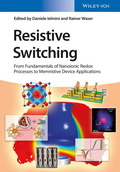Resistive Switching
From Fundamentals of Nanoionic Redox Processes to Memristive Device Applications

1. Auflage Februar 2016
XXVI, 755 Seiten, Hardcover
180 Abbildungen (50 Farbabbildungen)
Handbuch/Nachschlagewerk
Kurzbeschreibung
Dieses umfassende und wertvolle Referenzwerk führt die Leser in dieses breit gefächerte Fachgebiet ein, vermittelt das notwendige Wissen, Werkzeuge und Methoden, um Speicher mit resistiver Schaltung zu verstehen, zu charakterisieren und einzusetzen.
Jetzt kaufen
Preis: 219,00 €
Preis inkl. MwSt, zzgl. Versand
Euro-Preise für Wiley-VCH- und Ernst & Sohn-Titel sind nur für Deutschland gültig. In EU-Ländern gilt die lokale Mehrwertsteuer. Portokosten werden berechnet.
With its comprehensive coverage, this reference introduces readers to the wide topic of resistance switching, providing the knowledge, tools, and methods needed to understand, characterize and apply resistive switching memories.
Starting with those materials that display resistive switching behavior, the book explains the basics of resistive switching as well as switching mechanisms and models. An in-depth discussion of memory reliability is followed by chapters on memory cell structures and architectures, while a section on logic gates rounds off the text.
An invaluable self-contained book for materials scientists, electrical engineers and physicists dealing with memory research and development.
TRANSITION METAL OXIDES
Atomic Structures of Selected Binary, Ternary Oxides
Deposition Techniques
Thermodynamics of Oxidation, Ellingham Diagram
Electronic Structure and Conduction
Correlated Electrons
Ionic Conduction
RESISTIVE SWITCHING
Device Structure
Unipolar Switching: Forming, Set/Reset Operations
Bipolar Switching: Forming, Set/Reset Operations
Coexistence of Unipolar/Bipolar Switching
Filamentary Switching and Atomic Force Microscopy Analysis
Interface Switching
Threshold and Memory Switching
Time Dependence of Set/Reset
Resistance Dependence of Set/Reset
SWITCHING MECHANISMS AND MODELS
Unipolar Switching: Set/Reset Mechanisms and Models
Bipolar Switching: Set/Reset Mechanisms and Models
Modeling of Resistance Dependence (Filament Size and Gap)
Modeling of Time Dependence
Modeling of Set Current Dependence
Overshoot and Parasitic Effects
Material Dependence and Universal Switching
MEMORY RELIABILITY
Read Disturb and The Time-Voltage Dilemma
Data Retention
1/f and Random Telegraph Signal Noise
Switching Variability and Set/Reset Algorithms
Reset Current Reduction
Set/Reset Instability
Cycling Endurance
MEMORY CELL STRUCTURES
MIM Structures
Bilayered Structures
Lighting-Rod Structures
Contact RRAM
Complementary Resistance Switch (CRS)
Multilevel Cells
Alternative Materials: OxRRAM, PoRRAM, CBRAM
Bottom-Up Approaches: Nanotubes, Nanowires and Self-Assembly
MEMORY ARCHITECTURES
Crossbar Array
Diode Selectors
Transistor Selectors
1T1R Architectures
CMOL
Scaling Issues (Series Resistance, Programming Cross Talk, 3D Stacking Issues)
LOGIC GATES
The Memristor
Crossbar Latch
Data Restoration
IMP Function
STDP in Memristor Gates
CONCLUSIONS
Rainer Waser is professor at the faculty for Electrical Engineering and Information Technology at the RWTH Aachen University and director at the Peter Grünberg Institute at the Forschungszentrum Jülich (FZJ), Germany. His research group is focused on fundamental aspects of electronic materials and on such integrated devices as nonvolatile memories, logic devices, sensors and actuators.
Professor Waser has published about 500 technical papers. Since 2003, he has been the coordinator of the research program on nanoelectronic systems within the Germany national research centres in the Helmholtz Association. In 2007, he has been co-founder of the Jülich-Aachen Research Alliance, section Fundamentals of Future Information Technology (JARA-FIT). In 2014, he was awarded the Gottfried Wilhelm Leibniz Prize of the Deutsche Forschungsgemeinschaft and the Tsungming Tu Award of the Ministry of Science and Technology of Taiwan.


